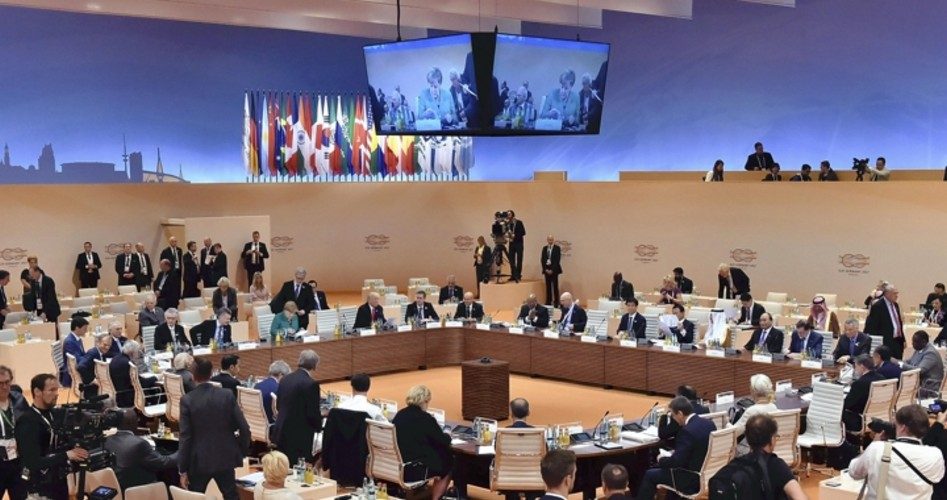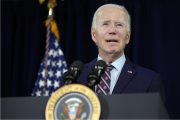
“Anti-fascism” protesters raged against the recent G20 Summit in Hamburg, Germany, burning cars, looting shops, and inevitably clashing with police. Such violent protests give an appearance that the participants in the summit are the conservatives, maintaining free market capitalism against the radical socialists in the streets.
The reality, however, is far different.
For decades, many of the wealthy globalists who favor worldwide socialism have directly or indirectly used street radicals to give a false impression that they themselves are supporters of “free” enterprise. It is no different with the political leaders of the G20 countries: They are not free market advocates, but rather they want “managed trade,” with themselves as the managers.
Among the chief opponents to President Trump at the summit was France’s newly-elected president Emanuel Macron. He lectured Trump on the benefits of globalization, using his Apple iPhone as an example. Macron noted that the phone was designed in the United States, but it was made in China with some American-made parts, and then sold in Europe.
Cast by the compliant media as some sort of “centrist,” Macron is a former member of the Socialist Party, but he was employed by a Rothschild banking house as an international banker — a vivid illustration that Big Finance Capitalism cannot be assumed to be the enemy of socialism.
This is clearly demonstrated if one examines the history of the Bolshevik Revolution that brought communism to power in the short-lived Russian Republic in 1917. Several sources have gathered evidence for western “capitalists” backing the Bolsheviks (including Lenin, Trotsky, and Stalin) in imposing a totalitarian system on the people of Russia. Antony Sutton, a scholar at Stanford, made the case for this in his book Wall Street and the Bolshevik Revolution. Another important source was Arsene de Goulevitch, a general of the “White Russian Army.” (The White Russian Army failed to stop the Communist takeover of Russia in a civil war that dragged on for years.) In his book Czarism and the Revolution, Goulevitch wrote, “The main purveyors of funds for the revolution, however, were neither the crackpot Russian millionaires nor the armed bandits of Lenin. The ‘real’ money primarily came from certain British and American circles which for a long time past had lent their support to the Russian revolutionary cause.”
Even after the evil character of the Soviet system should have been clear to everyone, this help from Western investments continued. In his three-volume history, Western Technology and Soviet Economic Development, Antony Sutton used mostly State Department documents to prove beyond a reasonable doubt that it was Western technology that kept the Soviet Union from disintegrating in its early years. One might recall the quotation attributed to Vladimir Lenin: “When it comes to hang the capitalists, they will compete with each other to sell us the rope at a lower price.”
Even national socialist Adolf Hitler was able to obtain financing from German industrialists, and even foreign sources as well, that helped him in his ascension to power in the 1930s. (Sutton has written of this as well, in his book Wall Street and the Rise of Hitler.)
The men in business suits, and women in expensive dresses at meetings such as the G20 may not look like leftist radicals, but they are generally ardent socialists in their own countries, favoring government controls over business, and global governance. However, compared to radicals overturning cars and smashing store windows, they appear to the average person as pillars of society and supporters of free enterprise.
James Kunen was a founder of the Students for a Democratic Society (SDS), an organization that evolved from the Intercollegiate Socialist Society. In his Strawberry Statement, written during the heyday of the radical ’60s, he stated that Big Business sought to channel funds to the SDS as part of a dialectical process. He made his point with a fascinating story from his attempts to organize the SDS in college. “In the evening, I went up to the University to check out a strategy meeting. A kid was giving a report on the SDS convention. He said that at the convention men from Business International Roundtables, the meetings sponsored by Business International for their client groups and heads of government — tried to buy up a few radicals. These men are the world’s leading industrialists and they convene to decide how our lives are going to go. These are the boys who wrote the Alliance for Progress. They’re the left wing of the ruling class.… They offered to finance our demonstrations in Chicago. We were offered Esso (Rockefeller) money. They want us to make a lot of radical commotion so they can look more in the center as they move to the left.”
This should cause us to wonder about just who is financing the rising tide of riots we have seen in America in recent years.
It is important to remember that just because a man puts on a high-dollar suit and tie does not make him a conservative. He may be just as radical, and in some cases, even more so, than the protesters in the streets. U.S. government official Alger Hiss, for example, uncovered as a Soviet spy in 1948, had previously been viewed by most as a pillar of American society.
Photo of Working Session at G20 Summit in Hamburg, Germany: AP Images


